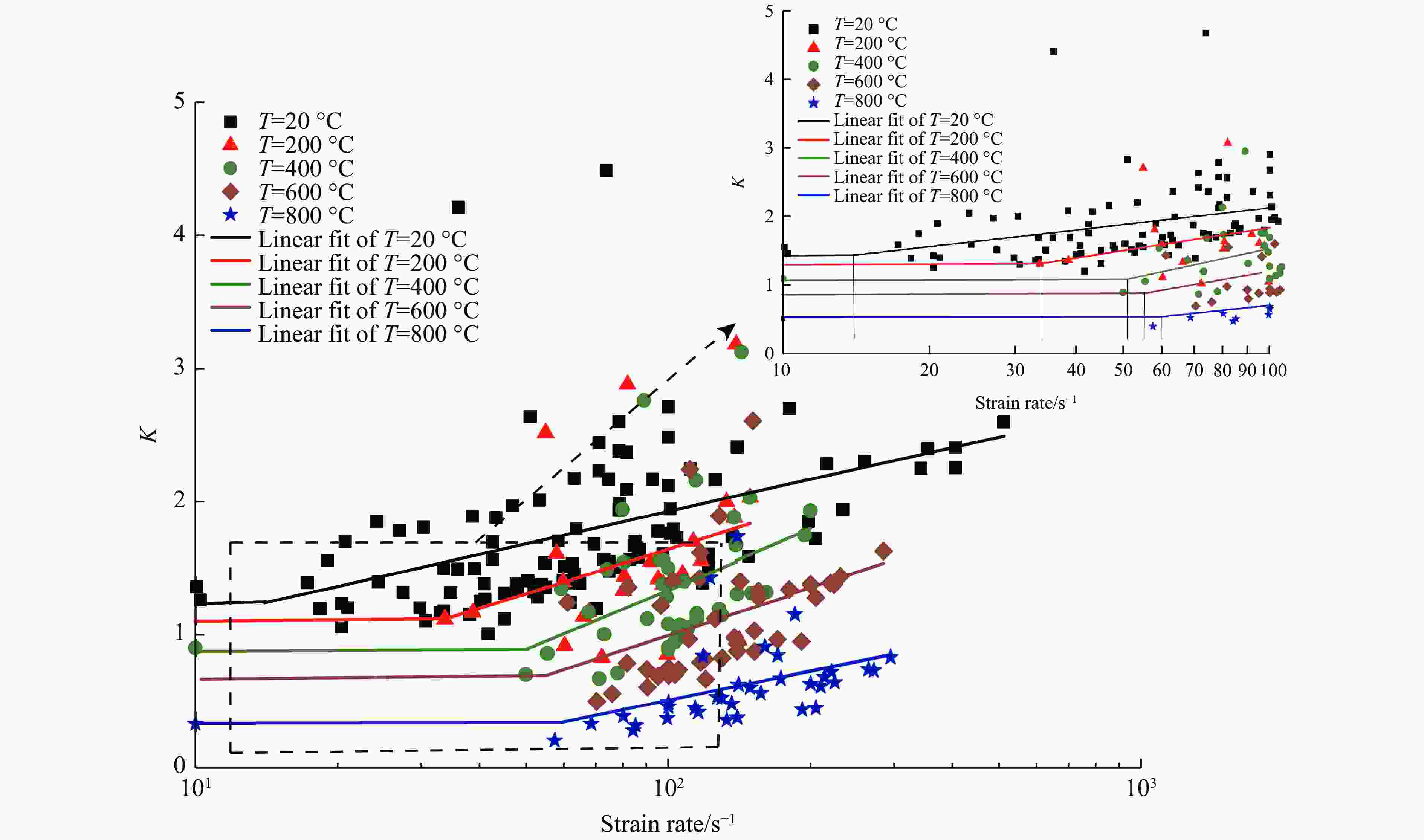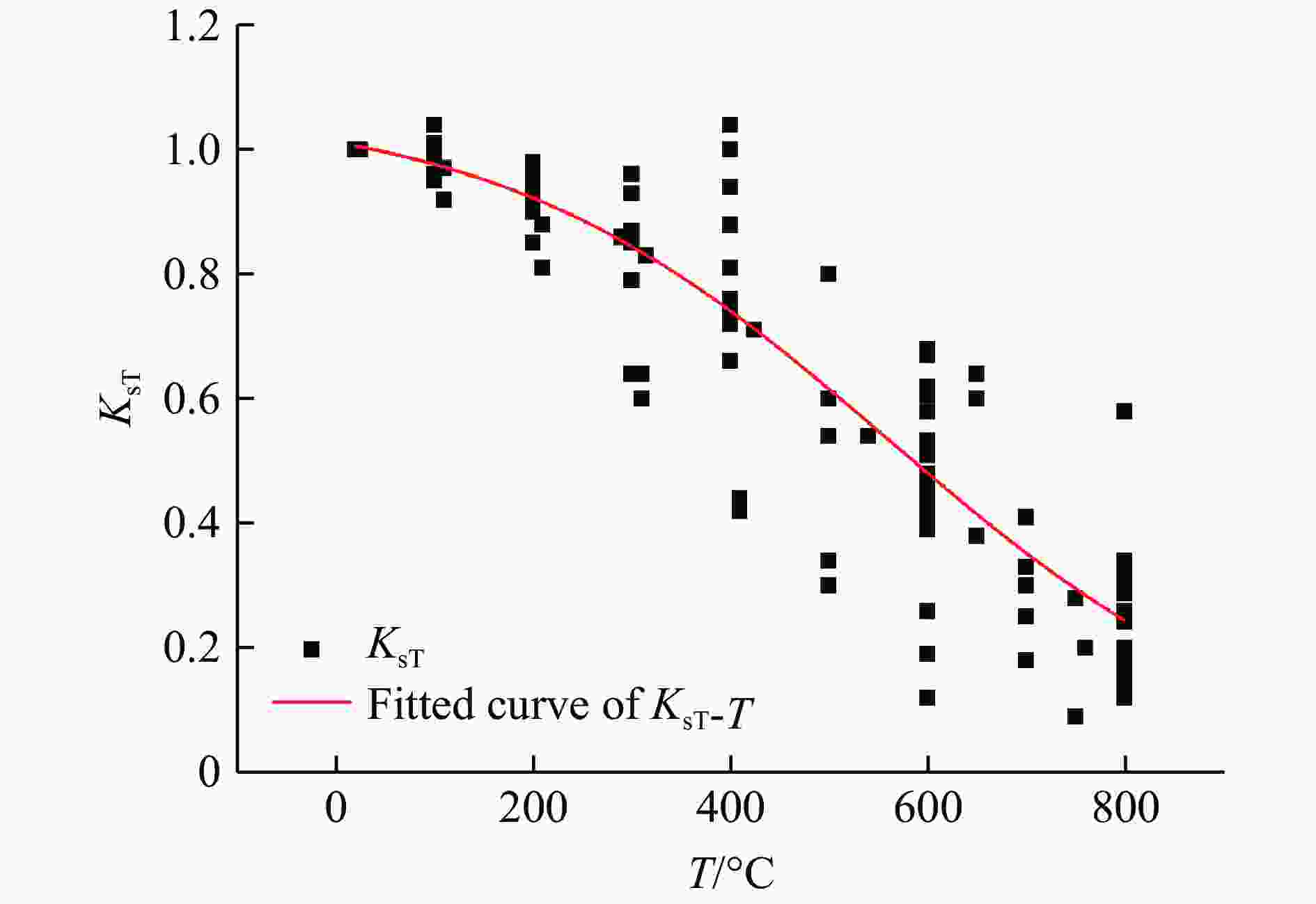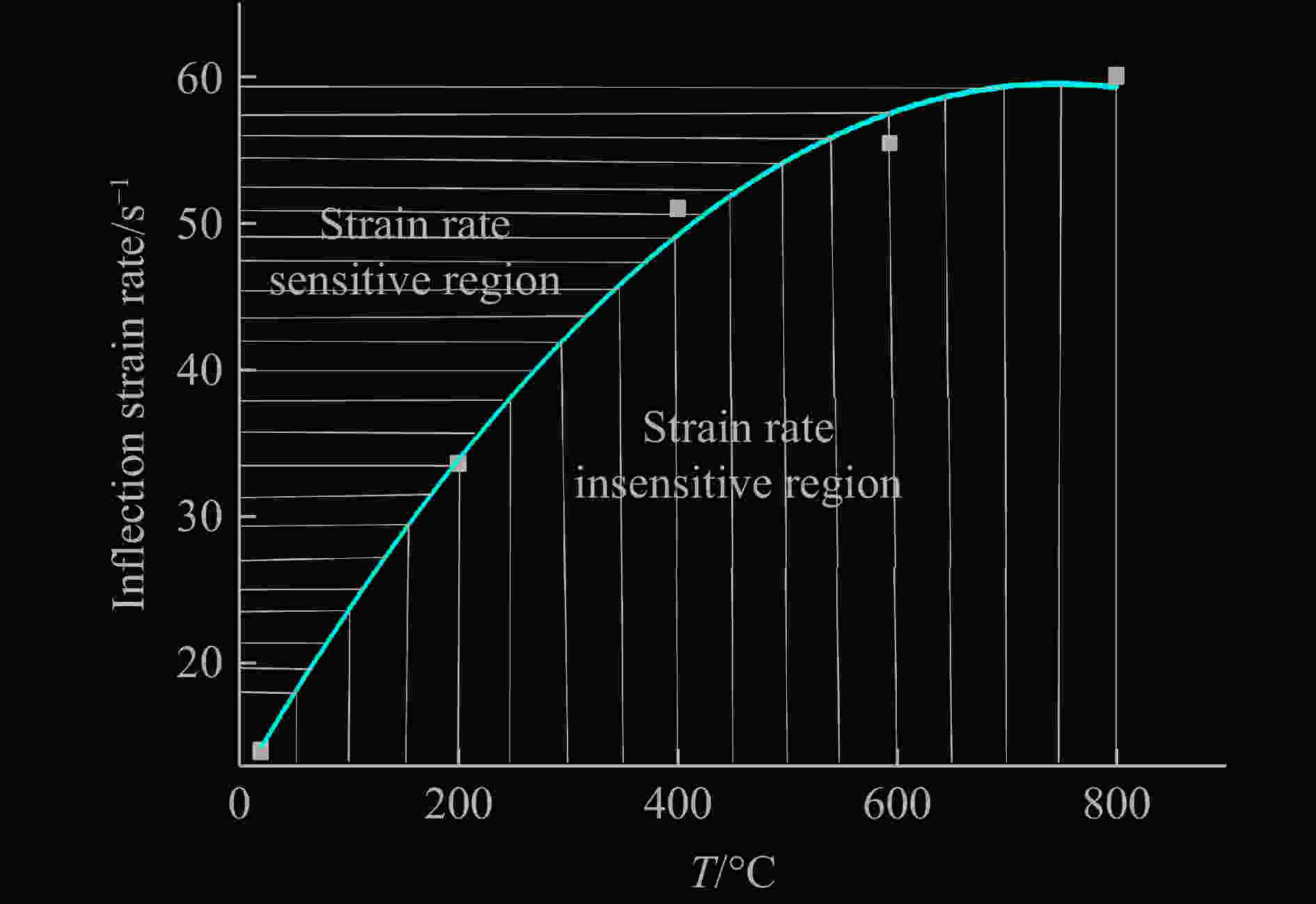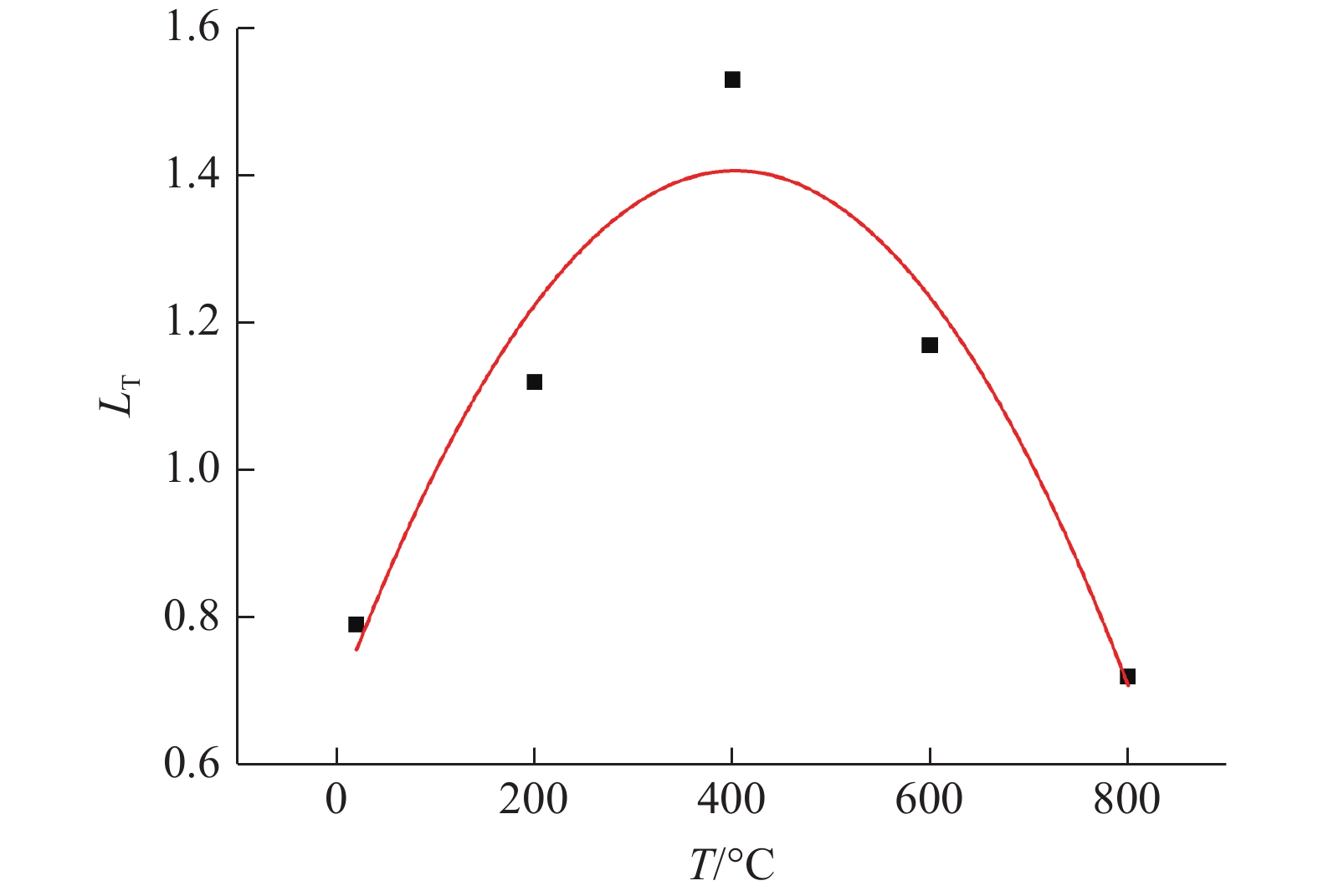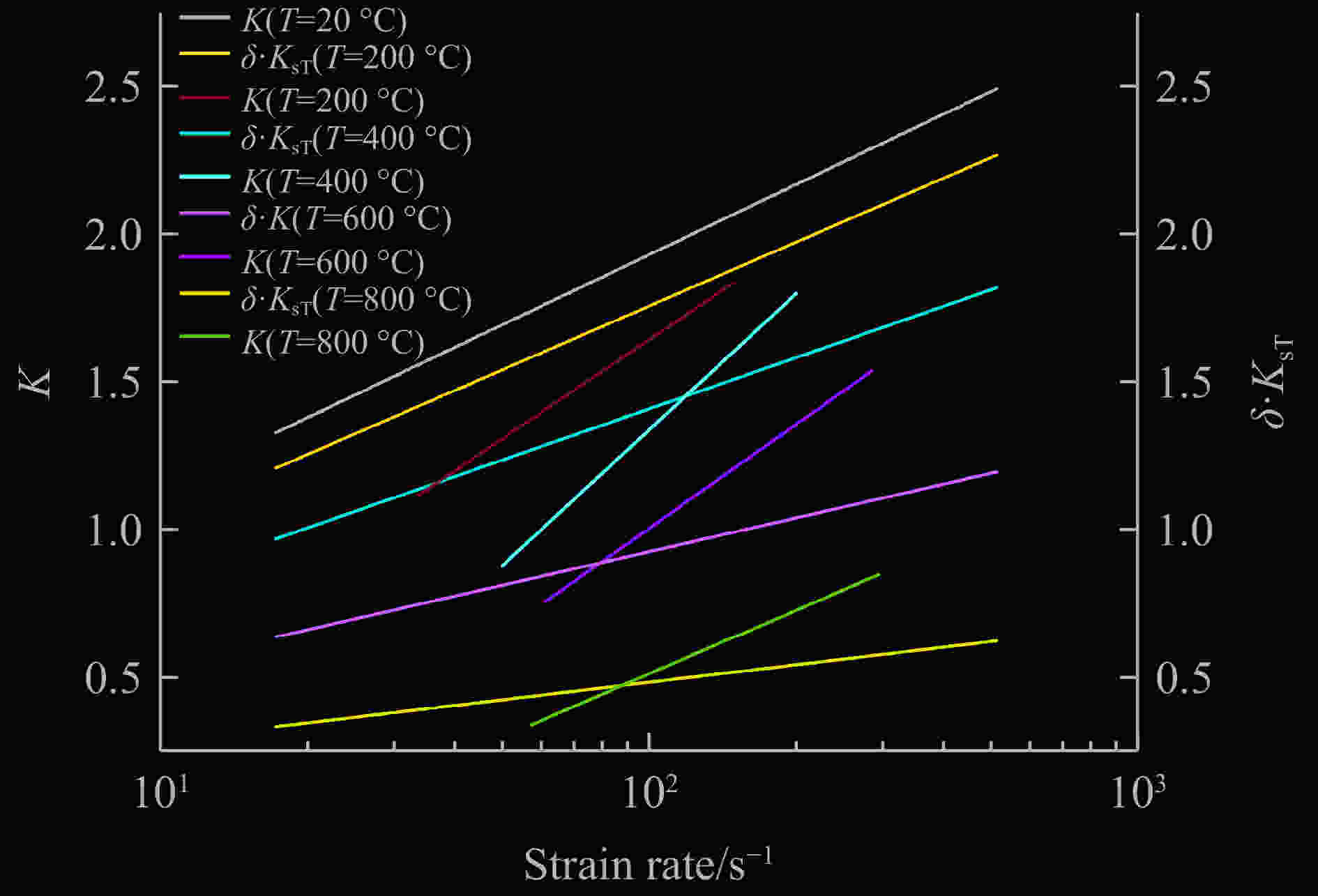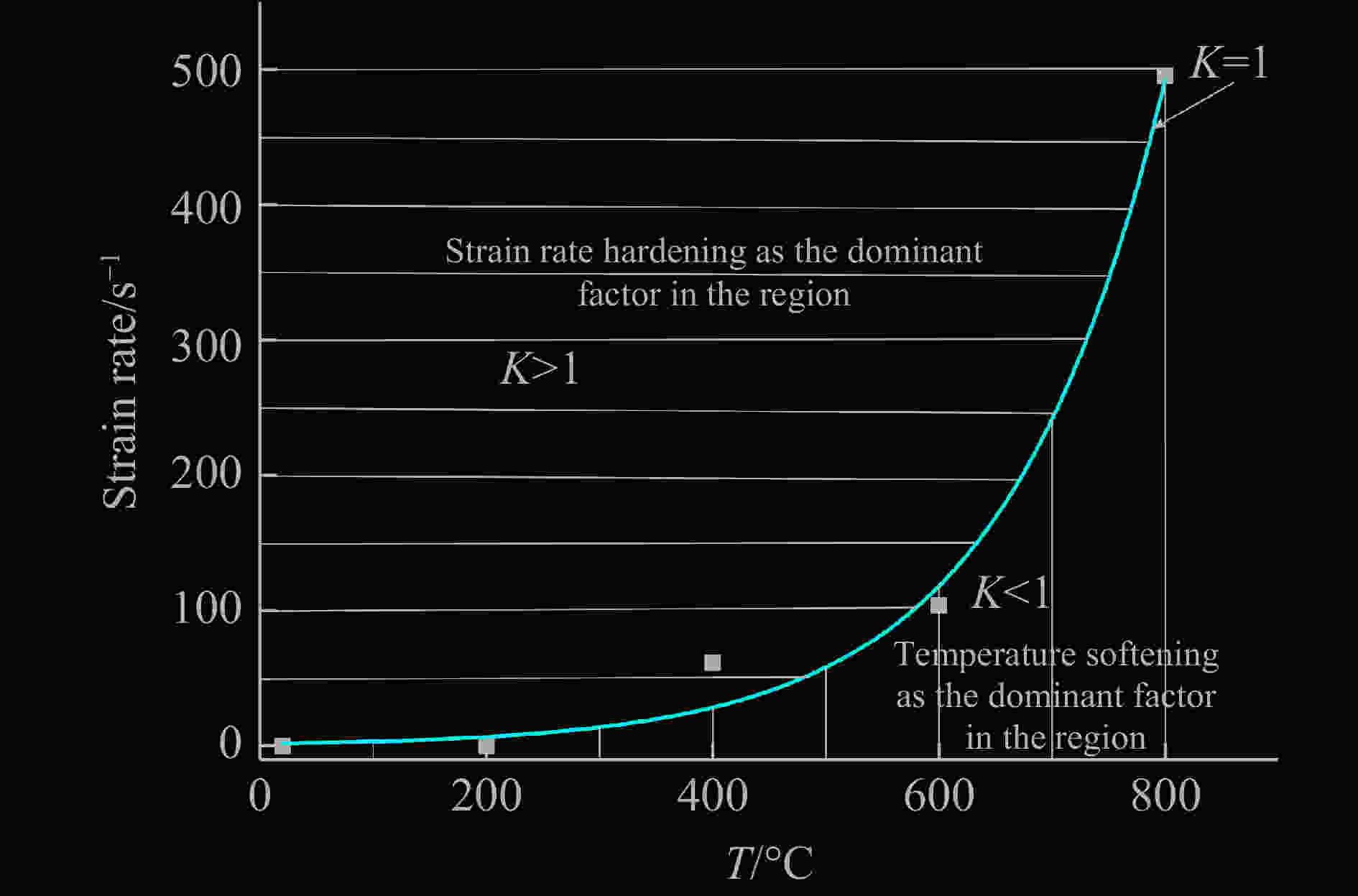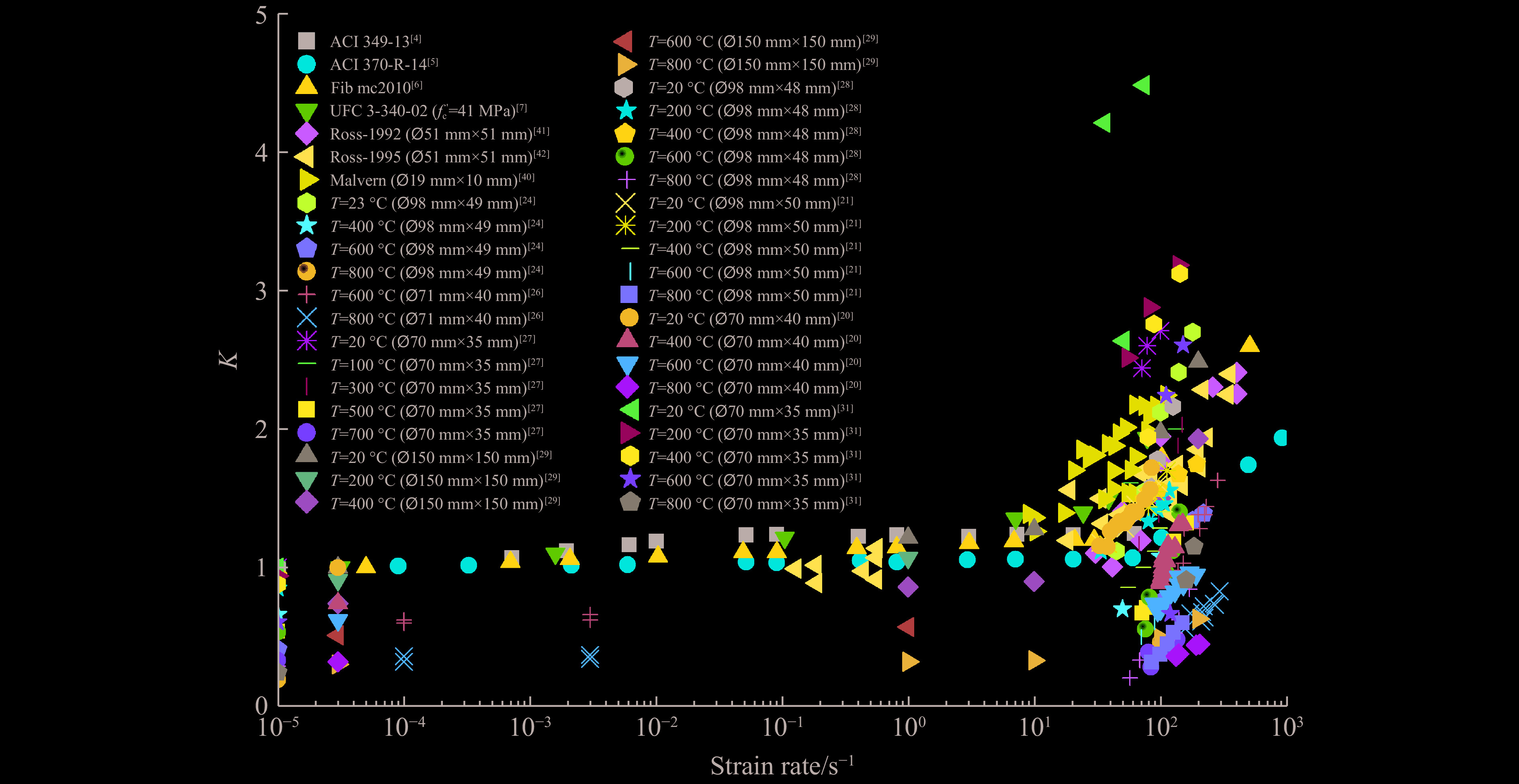The Law of Combined Effect of Rate and Temperature on Compressive Strength of Concrete Materials
-
摘要: 混凝土材料的动态压缩强度不仅具有明显的应变率强化(硬化)效应,同时还具有明显的温度弱化(软化)效应。在应变率和温度联合条件下,压缩强度随应变率和温度变化过程中不仅存在清晰的应变率拐折点,拐折点前后压缩强度随应变率变化速率明显不同,而且在不同温度下发生拐折时,其拐折点对应的应变率也存在明显差异。参考近年来相关文献中混凝土材料在率温联合条件下的压缩实验数据,结合理论分析,探讨了在不同温度、不同应变率条件下混凝土材料压缩强度联合效应因子K的变化规律;并对实验数据进行拟合,得到了不同应变率、不同温度下K(T)-
$\dot{\varepsilon} $ 的预测表达式,确定了应变率强化和温度弱化对压缩强度的耦合影响;通过分析应变率拐折点与温度的关系,确定了应变率和温度联合条件下应变率敏感区和不敏感区的率温联合条件界限;建立了率温效应相当(K = 1)时的率温等效方程,并确定了混凝土材料的率温等效参数。Abstract: The dynamic compressive strength of concrete material not only has obvious strain rate strengthening (hardening) effect, but also has obvious temperature weakening (softening) effect. Under the combined condition of strain rate and temperature, there are not only clear strain rate inflection point in the process of compression strength changing with strain rate and temperature, the change of compression strength with strain rate is obviously different before and after the inflection point. Under the same condition, there also are significant differences in the strain rate values corresponding to the inflection points which are existed when the curve bends at different temperatures. Combined with theoretical analysis and references to the compression experimental data of concrete materials under the combined temperature and strain rate condition in recent years, the variation law of the joint effect factor K of concrete compressive strength under different temperatures (T) and different strain rates ($\dot {\varepsilon} $ ) is discussed. By fitting the experimental data, the prediction expressions of K(T)-$\dot{\varepsilon} $ at different strain rates and different temperatures were obtained, and the coupling effects of strain rate hardening and temperature softening on compression strength were determined. The relationship between the inflection point of strain rate and temperature is analyzed, and the combined rate-temperature boundary for strain rate sensitive and strain rate insensitive region is determined. The rate-temperature equivalent equation is established when the rate-temperature effect is equivalent (namely, K=1) and the rate-temperature equivalent parameters of concrete materials are determined. -
表 1
$ K\text{-}\dot{\varepsilon} $ 拟合方程中的相关参数Table 1. Relevant parameters in
$K\text{-}\ \dot{\varepsilon} $ fitting equationT/℃ Ls $ \dot{\varepsilon} $in/s−1 Kin LT 20 0.034 14.0 1.22 0.79 200 0.031 33.6 1.11 1.12 400 0.021 51.0 0.88 1.53 600 0.030 55.5 0.68 1.17 800 0.013 60.0 0.34 0.72 表 2
$K=1$ 时各温度下的应变率Table 2. Strain rates at different temperatures when
$K=1$ Temperature/℃ Strain rate/s−1 20 10−5 200 0.008 400 61.1 600 104.2 800 495.2 -
[1] Comite Euro-International du Beton. Concrete structures under impact and impulsive loading [S]. Bulletin d'Information, Lausanne, 1988. [2] Comite Euro-International du Beton. CEB-FIP model code 1990 [M]. Lausanne: Committee Euro-International du Beton, 1993. [3] 高光发. 混凝土材料动态压缩强度的应变率强化规律 [J]. 高压物理学报, 2017, 31(3): 261–270. doi: 10.11858/gywlxb.2017.03.007GAO G F. Effect of strain-rate hardening on dynamic compressive strength of plain concrete [J]. Chinese Journal of High Pressure Physics, 2017, 31(3): 261–270. doi: 10.11858/gywlxb.2017.03.007 [4] ACI Committee 349. Code requirements for nuclear safety-related concrete structures (ACI 349-13) & commentary [S]. Farmington Hills, MI: American Concrete Institute, 2013. [5] ACI Committee 370. Report for the design of concrete structures for blast effects: ACI 370R-2014 [S]. Farmington Hills, MI: American Concrete Institute, 2014. [6] Fib Commission 8. Code-type models for concrete behaviour: state-of-the-art report 70 [R]. Lausanne: Fib Fédération Internationale du Béton, 2013. [7] Unified Facilities Criteria (UFC) 3-340-02. Structures to resist the effects of accidental explosions [R]. Washington D C, US: Department of Defense, 2008. [8] PHAM D-T, VU M-N, TRIEU H T, et al. A thermo-mechanical meso-scale lattice model to describe the transient thermal strain and to predict the attenuation of thermo-mechanical properties at elevated temperature up to 800 ℃ of concrete [J]. Fire Safety Journal, 2020, 114: 103011. doi: 10.1016/j.firesaf.2020.103011 [9] AISC. Specification for structural steel buildings: ANSI/AISC 360-10 [S]. Chicago, IL: American Institute of Steel Construction, Inc., 2010. [10] Eurocode 2: design of concrete structures-part 1-2: general rules—structural fire design: EN 1992-1-2 [S]. Brussels: European Committee for Standardization, 2004. [11] CHAN Y N, PENG G F, ANSON M. Residual strength and pore structure of high-strength concrete and normal strength concrete after exposure to high temperatures [J]. Cement and Concrete Composites, 1999, 21: 23–27. doi: 10.1016/S0958-9465(98)00034-1 [12] NOVAK J, KOHOUTKOVA A. Mechanical properties of concrete composites subject to elevated temperature [J]. Fire Safety Journal, 2018, 95: 66–76. doi: 10.1016/j.firesaf.2017.10.010 [13] SESHU D R, PRATUSHA A. Study on compressive strength behaviour of normal concrete and self-compacting concrete subjected to elevated temperatures [J]. Magazine of Concrete Research, 2013, 65(7): 415–421. doi: 10.1680/macr.12.00108 [14] SIDERIS K K. Mechanical characteristics of self-consolidating concrete exposed to elevated temeperatures [J]. ASCE Journal of Materials in Civil Engineering. 2007, 19(8): 648–654. [15] PERSSON B. Fire resistance of self-compacting concrete [J]. Materials and Structures, 2004, 37: 575–584. [16] KHALIQ W, KODUR V. Thermal and mechanical properties of fiber reinforced high performance self-consolidating concrete at elevated temperatures [J]. Cement and Concrete Research, 2011, 41: 1112–1122. [17] ABRAMS M S. Compressive strength of concrete at temperatures to 1600F [J]. Michigan, USA: ACI Special Publication, 1971, 25: 33–58. [18] MALHOTRA H L. The effect of temperature on the compressive strength of concrete [J]. Magazine of Concrete Research, 1956, 8(23): 85–94. doi: 10.1680/macr.1956.8.23.85 [19] LIE T T. Structural fire protection [M]. New York: American Society of Civil Engineers, 1992. [20] CHEN L, FANG Q, JIANG X Q, et al. Combined effects of high temperature and high strain rate on normal weight concrete [J]. International Journal of Impact Engineering, 2015, 86: 40–56. doi: 10.1016/j.ijimpeng.2015.07.002 [21] REN W B, XU J Y, SU H Y. Dynamic compressive behaviour of concrete after exposure to elevated temperatures [J]. Materials and Structures, 2016, 49: 3321–3334. [22] ABRAM D A. Effect of rate of application of load on the compressive strength of concrete [M] . Proceeding of ASTM 17, Part 2, 1917: 364–377. [23] ZHAI Y, DENG Z C, LI N, et al. Study on compressive mechanical capabilities of concrete after high temperature exposure and thermo-damage constitutive model [J]. Construction and Building Materials, 2014, 68: 777–782. doi: 10.1016/j.conbuildmat.2014.06.052 [24] LIU C X, LI Y L. Effects of temperature and strain-rate on the compressive strength of concrete [J]. Advanced Materials Research, 2011, 168/169/170: 2619–2624. [25] XING Z, BEAUCOUR A-L, HEBERT R, et al. Influence of the nature of aggregates on the behaviour of concrete subjected to elevated temperature [J]. Cement and Concrete Research, 2011, 41: 392–402. doi: 10.1016/j.cemconres.2011.01.005 [26] ZHAI C C, CHEN L, FANG Q, et al. Experimental study of strain rate effects on normal weight concrete after exposure to elevated temperature [J]. Materials and Structures, 2017, 50: 40. doi: 10.1617/s11527-016-0879-4 [27] HUO J S, HE Y M, XIAO L P, et al. Experimental study on dynamic behaviours of concrete after exposure to high temperatures up to 700 ℃ [J]. Materials and Structures, 2013, 46: 255–265. doi: 10.1617/s11527-012-9899-x [28] LI Z W, XU J Y, BAI E L. Static and dynamic mechanical properties of concrete after high temperature exposure [J]. Materials Science and Engineering: A, 2012, 544: 27–32. doi: 10.1016/j.msea.2012.02.058 [29] JIN L, HAO H M, ZHANG R B, et al. Mesoscale simulation on the effect of elevated temperature on dynamic compressive behavior of steel fiber reinforced concrete [J]. Fire Technology, 2020, 56(4): 1801–1823. doi: 10.1007/s10694-020-00955-5 [30] LU Y B, LI Q M. About the dynamic uniaxial tensile strength of concrete-like materials [J]. International Journal of Impact Engineering, 2011, 38(4): 171–180. [31] 彭帅, 李亮, 吴俊, 等. 高温条件下钢纤维混凝土动态抗压性能试验研究 [J]. 振动与冲击, 2019, 38(22): 149–154.PENG S, LI L, WU J, et al. Impact tests on dynamic compressive behaviors of steel fiber reinforced concrete at elevated temperature [J]. Journal of Vibration and Shock, 2019, 38(22): 149–154. [32] 陶俊林, 秦李波, 李奎, 等. 混凝土高温动态压缩力学性能实验 [J]. 爆炸与冲击, 2011, 31(1): 101–106.TAO J L, QIN L B, LI K, et al. Experimental investigation on dynamic compression mechanical performance of concrete at high temperature [J]. Explosion and Shock Waves, 2011, 31(1): 101–106. [33] 许金余, 刘健, 范飞林, 等. 高温SHPB冲击实验技术及其应用 [J]. 高压物理学报, 2013, 27(1): 57–62. doi: 10.11858/gywlxb.2013.01.008XU J Y, LIU J, FAN F L, et al. A high temperature SHPB impact experimental technique and its application [J]. Chinese Journal of High Pressure Physics, 2013, 27(1): 57–62. doi: 10.11858/gywlxb.2013.01.008 [34] 刘传雄, 李玉龙, 吴子燕, 等. 高温后混凝土材料的动态压缩力学性能 [J]. 土木工程学报, 2011, 44(4): 78–83.LIU C X, LI Y L, WU Z Y, et al. Dynamic compression behavior of heated concrete [J]. Chinese Civil Engineering Journal, 2011, 44(4): 78–83. [35] HUANG R Y, LI S C, MENG L, et al. Coupled effect of temperature and strain rate on mechanical properties of steel fiber-reinforced concrete [J]. International Journal of Concrete Structures and Materials, 2020, 14: 48. doi: 10.1186/s40069-020-00423-y [36] JOHNSON G R, COOK W H. A constitutive model and data for metals subjected to large strains, high strain rates and high temperatures [J]. Engineering Fracture Mechanics, 1983, 21: 541–548. [37] JOHNSON G R, COOK W H. Fracture characteristics of three metals subjected to various strains, strain rates, temperatures and pressures [J]. Engineering Fracture Mechanics, 1985, 21(1): 31–48. doi: 10.1016/0013-7944(85)90052-9 [38] Eurocode 4: design of composite steel and concrete structures [S]. New Zealand: Manager Structural Systems, Heavy Engineering Research Association, 1994. [39] YOUN S, LEE S-B, LEE H-Y, et al. Implementation of thermo-viscoplastic constitutive equations into the finite element code ABAQUS [C]//15th International Conference on Structural Mechanics in Reactors Technology. Seoul, Korea, 1998. [40] MALVERN L E, ROSS C A. Dynamic response of concrete and concrete structures: ADA173082 [R]. Gainesville: University of Florida, 1985. [41] ROSS C A. Crack patterns resulting from high strain-rate tests on concrete: ADA260240 [R]. Florida: Air Base Survivability Branch, 1992. [42] ROSS C A, TEDESCO J W, KUENNEN S T. Effects of strain rate on concrete strength [J]. Aci Materials Journal, 1995, 92(1): 37–47. [43] LEE S, KIM K-M, PARK J, et al. Pure rate effect on the concrete compressive strength in the split Hopkinson pressure bar test [J]. International Journal of Impact Engineering, 2018, 113: 191–202. doi: 10.1016/j.ijimpeng.2017.11.015 [44] LINDHOLM U S. Some experiments in dynamic plasticity under combined stress [M]//Mechanical Behavior of Materials under Dynamic Loads. New York: Springer Verlag, 1968, 77–95. [45] CAMPBELL J D, FERGUSON W G. The temperature and strain-rate dependence of the shear strength of mild steel [J]. Philosophical Magazine, 1970, 21: 63–82. doi: 10.1080/14786437008238397 [46] 王礼立, 胡时胜, 杨黎明, 等. 材料动力学 [M] 合肥: 中国科学技术大学出版社, 2017: 131. [47] YU X, CHEN L, FANG Q, et al. A concrete constitutive model considering coupled effects of high temperature and high strain rate [J]. International Journal of Impact Engineering, 2017, 101: 66–77. [48] ZENER C, HOLLOMON J H. Effect of strain rate upon plastic flow of steel [J]. Journal of Applied Physics, 1944, 15(1): 22–32. doi: 10.1063/1.1707363 -









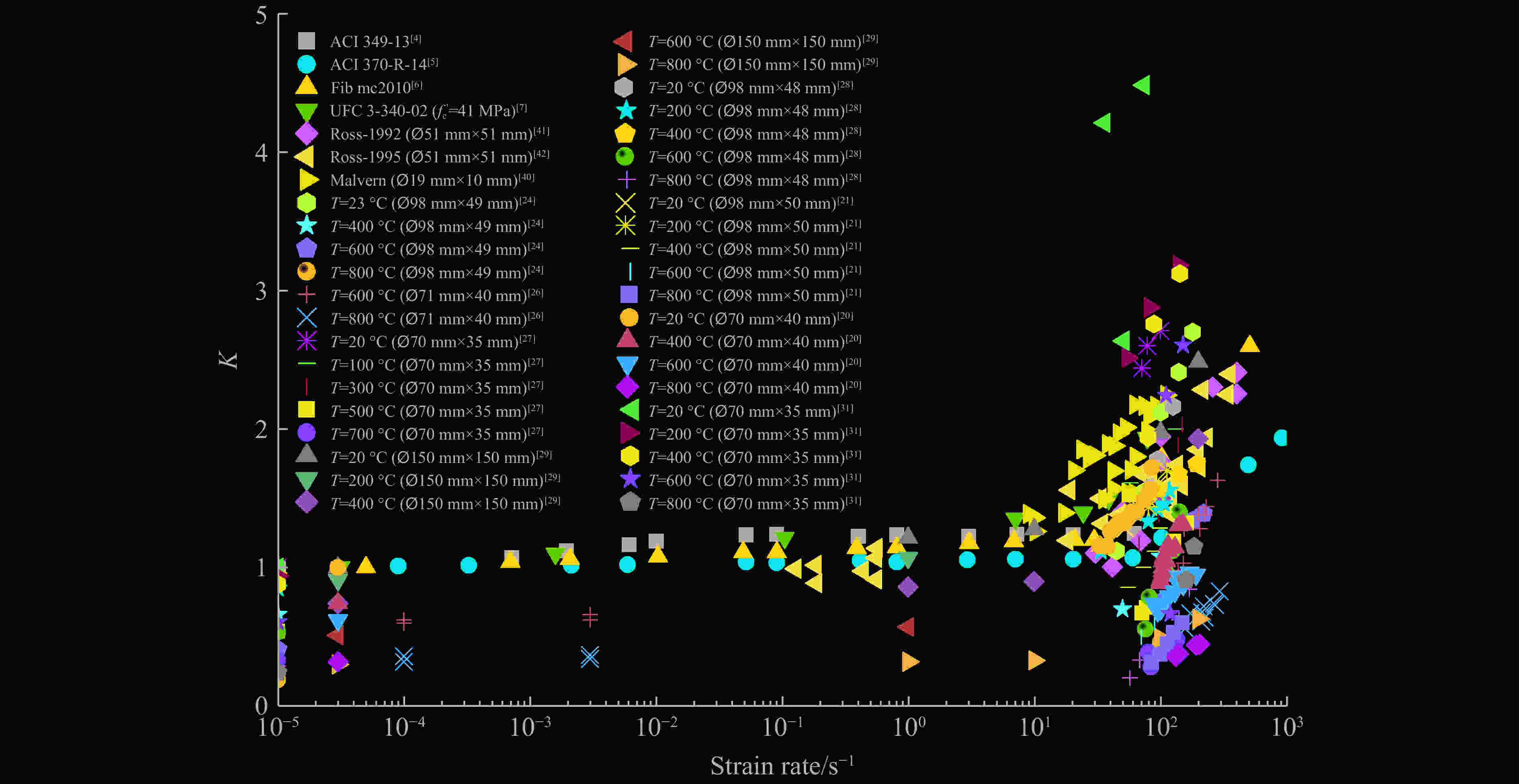
 下载:
下载:



